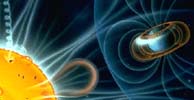| . |  |
. |
 Washington - December 13, 1999 - A rare space weather event May 11 marked by a sharp decrease in solar wind helped cause Earth's magnetosphere to balloon to more than 100 times its normal volume, reaching nearly to the moon in the process, according to a new study.
Washington - December 13, 1999 - A rare space weather event May 11 marked by a sharp decrease in solar wind helped cause Earth's magnetosphere to balloon to more than 100 times its normal volume, reaching nearly to the moon in the process, according to a new study.Daniel Baker, director of the University of Colorado's at Boulder's Laboratory for Atmospheric and Space Physics, said the density and speed of the particle-toting solar wind creates a dynamic pressure that confines Earth's magnetic field to form its magnetosphere. Under normal conditions, a cross-section of Earth's magnetosphere resembles a halved apple, although a comet-like tail sweeps back from the side of the planet facing away from the sun. But on May 11, the solar wind density - the number of energetic electrons and protons per cubic centimeter -- was only about 2 percent of normal, and the wind's speed dropped by more than half. This caused the pressure on the magnetic field to plummet by more than 99 percent, said Baker, lead author on the study. The event was dubbed by some scientists as "The Day the Solar Wind Ran Out of Gas." "This was a very rare occurrence that has been seen only a few times since satellites began taking solar wind measurements 35 years ago," he said. While the magnetosphere generally reaches out about 40,000 miles from Earth toward the sun, it stretched to nearly 235,000 miles on May 11, about the distance from the Earth to the moon. A paper on the subject by Baker, CU students Sean Yarborough and Niescja Turner and CU Research Associate Xinlin Li was presented at the fall meeting of the American Geophysical Union held Dec. 13 to Dec. 17 in San Francisco. Other co-authors included Shrikanth Kanekal of NASA's Goddard Space Flight Center, J.B. Blake of the Aerospace Corp. in Los Angeles and Howard Singer of the National Oceanic and Atmospheric Administration's Space Environment Center in Boulder. Baker and his colleagues used data from the SAMPEX, POLAR, GOES, GPS and many other satellites to take data on Earth's Van Allen radiation belts, which are deeply embedded in the magnetosphere. The radiation belts became much more symmetric during the event, with the comet-like tail of radiation apparently disappearing in the process. Although the density of energetic electrons in the solar wind returned to normal on May 12, as did the solar wind speed, the density of very high-energy electrons in the magnetosphere dropped mysteriously once again on May 13 and remained "severely depleted" for an extended period, said Baker. "It appears this episode fundamentally changed the magnetosphere by causing the energetic electrons to all but disappear for about two months," said Baker. "Everything the solar wind was throwing at the magnetosphere should have re-started its engine after May 13, but for some reason it failed." Although scientists once thought Earth's radiation belts slowly waxed and waned and were not particularly dynamic, they recently have been shown to be powerful particle accelerators for the magnetosphere's energetic electrons, he said. The solar wind spins off the rotating sun much like a circular lawn sprinkler sprays water, accelerating up to nearly 1 million to 2 million miles per hour by the time it hits Earth's magnetosphere, said Baker. "It's possible that a large 'vacuum bubble' formed on the edge of the sun and was blown toward Earth, causing the solar wind to slow and become less dense during the May 11 event," he said. "This illustrated the solar wind, like the radiation belts, are highly dynamic and variable." Although the shape of the magnetosphere and the density of its charged particles returned to normal levels after about two months, the surprising 1999 phenomenon may prove significant to space-weather experts like Baker. "I think these rare, extreme events eventually will help us to understand how the magnetosphere's engine works under normal circumstances," he said.
TERRADAILY.COM
|
| |||||||||
| The content herein, unless otherwise known to be public domain, are Copyright 1995-2016 - Space Media Network. All websites are published in Australia and are solely subject to Australian law and governed by Fair Use principals for news reporting and research purposes. AFP, UPI and IANS news wire stories are copyright Agence France-Presse, United Press International and Indo-Asia News Service. ESA news reports are copyright European Space Agency. All NASA sourced material is public domain. Additional copyrights may apply in whole or part to other bona fide parties. Advertising does not imply endorsement, agreement or approval of any opinions, statements or information provided by Space Media Network on any Web page published or hosted by Space Media Network. Privacy Statement All images and articles appearing on Space Media Network have been edited or digitally altered in some way. Any requests to remove copyright material will be acted upon in a timely and appropriate manner. Any attempt to extort money from Space Media Network will be ignored and reported to Australian Law Enforcement Agencies as a potential case of financial fraud involving the use of a telephonic carriage device or postal service. |